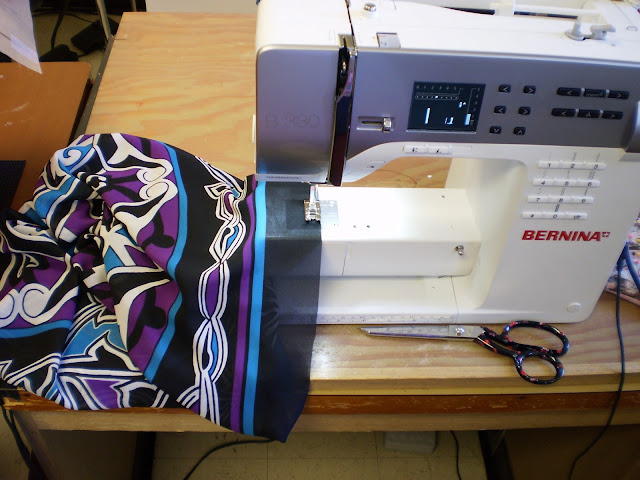So, for The Drowsy Chaperone the designer brought a whole bunch of fabrics back from his trip to London... and by fabrics... i mean Pashmina shawls that were covered in sequins and beading. He wanted this dress for "the Chaperone" made from 3 shawls. that's all i had to work with! It was a challenge worthy of Project Runway for sure.
So i made a mock up out of rectangles cut to the exact size of the Pashmina's so that i could make the most of the fabric i was given. After the initial mock up i hacked into those shawls and lined each piece to protect the beading stitches on the inside from snagging (a major problem we had encountered). The actress has a lovely curvy full-figure, so making a 20's style dress that draped straight was a challenge. The 2 shawls for the skirt's width equaled only a couple inches more than the actress' fullest hip measurement, so i needed to utilize the entire width, as she does some dancing and such in this costume.
The beginning stages were me trying to get the pleats on the skirt to drape nicely over the form, and working with the medallion and feathery pieces from a coordinating shawl to get a "capelet" effect.
The designer wanted these side panels from the 3rd shawl. They give a "faux pannier" (what the assistant designer refers to it as) look that the 20's was known to do on occasion.
Pinned in place.
Still figuring out the back medallion..
Sometimes with this project i felt like the designer was so committed to the fabric, that we changed a lot in the design in order to work with this medallion.. such a pain.. but that's the designer's right i guess.
So sparkly.
It made my whole corner of the shop like a disco ball in the mornings.
With the ruched top all pinned in place. This part was a lot of hand-stitching so that the ruching was perfect, and stayed that way.
looking lovely.
Here are some other pictures of various stages of being pinned and/or stitched.
We decided to have the "feather" come down to the waist so that we weren't getting that "arrow to the chest" effect of having it come to a point at the top of the décolletage.
More finished stages.
There is a drape-cape thing that goes over her arms that we tried to figure out using a hanger and an empty fabric tube. It's a lot-a-look.
The fitting with her went amazing and it looked much better on her form than on a male form that i padded out with a bra and batting... (man we need a plus-sized form!). I will post more pics on this project later. Needless to say that after the fitting the designer ate his words and retracted his previous comment that this was "quite possibly the most unflattering dress he had ever designed" and said that i did a beautiful job. The assistant designer (who i greatly trust and admire) complimented me twice on my construction and fit, and the actress gave me a hug, and a kiss on the cheek and said that she felt like a million bucks. This is why i do what i do. Making that actress feel like the most elegant fabulous person on the stage is why i keep going, even after discouraging comments. It's important to me to make everyone have that same feeling, whether they are stepping out on stage or walking out their front door.















































